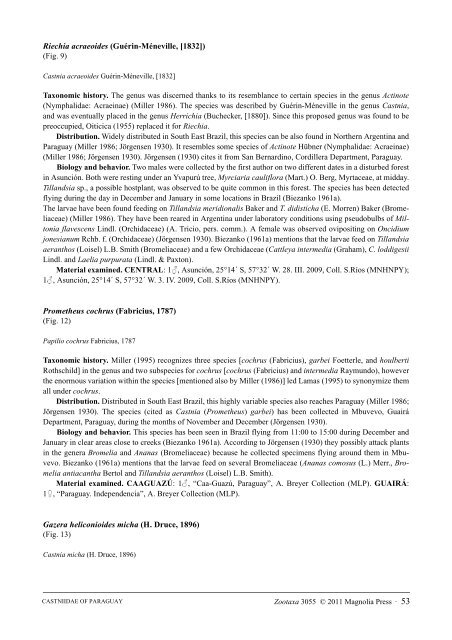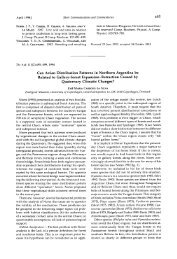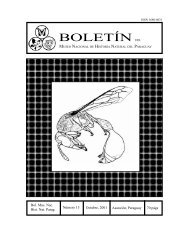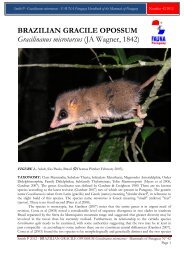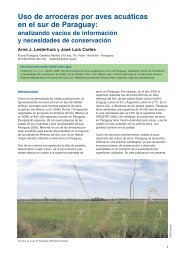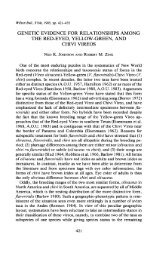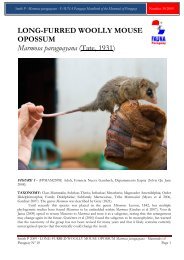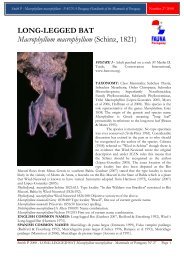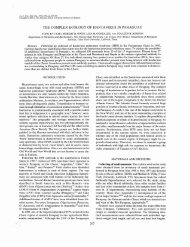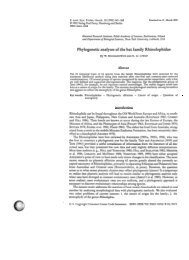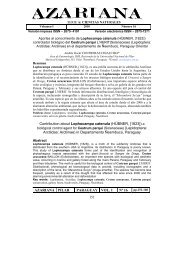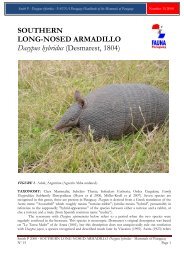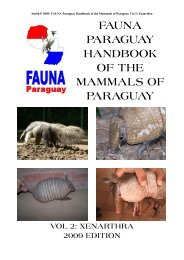A synopsis of the Castniidae (Lepidoptera) of ... - FAUNA Paraguay
A synopsis of the Castniidae (Lepidoptera) of ... - FAUNA Paraguay
A synopsis of the Castniidae (Lepidoptera) of ... - FAUNA Paraguay
Create successful ePaper yourself
Turn your PDF publications into a flip-book with our unique Google optimized e-Paper software.
Riechia acraeoides (Guérin-Méneville, [1832])<br />
(Fig. 9)<br />
Castnia acraeoides Guérin-Méneville, [1832]<br />
Taxonomic history. The genus was discerned thanks to its resemblance to certain species in <strong>the</strong> genus Actinote<br />
(Nymphalidae: Acraeinae) (Miller 1986). The species was described by Guérin-Méneville in <strong>the</strong> genus Castnia,<br />
and was eventually placed in <strong>the</strong> genus Herrichia (Buchecker, [1880]). Since this proposed genus was found to be<br />
preoccupied, Oiticica (1955) replaced it for Riechia.<br />
Distribution. Widely distributed in South East Brazil, this species can be also found in Nor<strong>the</strong>rn Argentina and<br />
<strong>Paraguay</strong> (Miller 1986; Jörgensen 1930). It resembles some species <strong>of</strong> Actinote Hübner (Nymphalidae: Acraeinae)<br />
(Miller 1986; Jörgensen 1930). Jörgensen (1930) cites it from San Bernardino, Cordillera Department, <strong>Paraguay</strong>.<br />
Biology and behavior. Two males were collected by <strong>the</strong> first author on two different dates in a disturbed forest<br />
in Asunción. Both were resting under an Yvapurú tree, Myrciaria cauliflora (Mart.) O. Berg, Myrtaceae, at midday.<br />
Tillandsia sp., a possible hostplant, was observed to be quite common in this forest. The species has been detected<br />
flying during <strong>the</strong> day in December and January in some locations in Brazil (Biezanko 1961a).<br />
The larvae have been found feeding on Tillandsia meridionalis Baker and T. didisticha (E. Morren) Baker (Bromeliaceae)<br />
(Miller 1986). They have been reared in Argentina under laboratory conditions using pseudobulbs <strong>of</strong> Miltonia<br />
flavescens Lindl. (Orchidaceae) (A. Tricio, pers. comm.). A female was observed ovipositing on Oncidium<br />
jonesianum Rchb. f. (Orchidaceae) (Jörgensen 1930). Biezanko (1961a) mentions that <strong>the</strong> larvae feed on Tillandsia<br />
aeranthos (Loisel) L.B. Smith (Bromeliaceae) and a few Orchidaceae (Cattleya intermedia (Graham), C. loddigesii<br />
Lindl. and Laelia purpurata (Lindl. & Paxton).<br />
Material examined. CENTRAL: 1♂, Asunción, 25°14´ S, 57°32´ W. 28. III. 2009, Coll. S.Ríos (MNHNPY);<br />
1♂, Asunción, 25°14´ S, 57°32´ W. 3. IV. 2009, Coll. S.Ríos (MNHNPY).<br />
Prome<strong>the</strong>us cochrus (Fabricius, 1787)<br />
(Fig. 12)<br />
Papilio cochrus Fabricius, 1787<br />
Taxonomic history. Miller (1995) recognizes three species [cochrus (Fabricius), garbei Foetterle, and houlberti<br />
Rothschild] in <strong>the</strong> genus and two subspecies for cochrus [cochrus (Fabricius) and intermedia Raymundo), however<br />
<strong>the</strong> enormous variation within <strong>the</strong> species [mentioned also by Miller (1986)] led Lamas (1995) to synonymize <strong>the</strong>m<br />
all under cochrus.<br />
Distribution. Distributed in South East Brazil, this highly variable species also reaches <strong>Paraguay</strong> (Miller 1986;<br />
Jörgensen 1930). The species (cited as Castnia (Prome<strong>the</strong>us) garbei) has been collected in Mbuvevo, Guairá<br />
Department, <strong>Paraguay</strong>, during <strong>the</strong> months <strong>of</strong> November and December (Jörgensen 1930).<br />
Biology and behavior. This species has been seen in Brazil flying from 11:00 to 15:00 during December and<br />
January in clear areas close to creeks (Biezanko 1961a). According to Jörgensen (1930) <strong>the</strong>y possibly attack plants<br />
in <strong>the</strong> genera Bromelia and Ananas (Bromeliaceae) because he collected specimens flying around <strong>the</strong>m in Mbuvevo.<br />
Biezanko (1961a) mentions that <strong>the</strong> larvae feed on several Bromeliaceae (Ananas comosus (L.) Merr., Bromelia<br />
antiacantha Bertol and Tillandsia aeranthos (Loisel) L.B. Smith).<br />
Material examined. CAAGUAZÚ: 1♂, “Caa-Guazú, <strong>Paraguay</strong>”, A. Breyer Collection (MLP). GUAIRÁ:<br />
1♀, “<strong>Paraguay</strong>. Independencia”, A. Breyer Collection (MLP).<br />
Gazera heliconioides micha (H. Druce, 1896)<br />
(Fig. 13)<br />
Castnia micha (H. Druce, 1896)<br />
CASTNIIDAE OF PARAGUAY<br />
Zootaxa 3055 © 2011 Magnolia Press · 53


